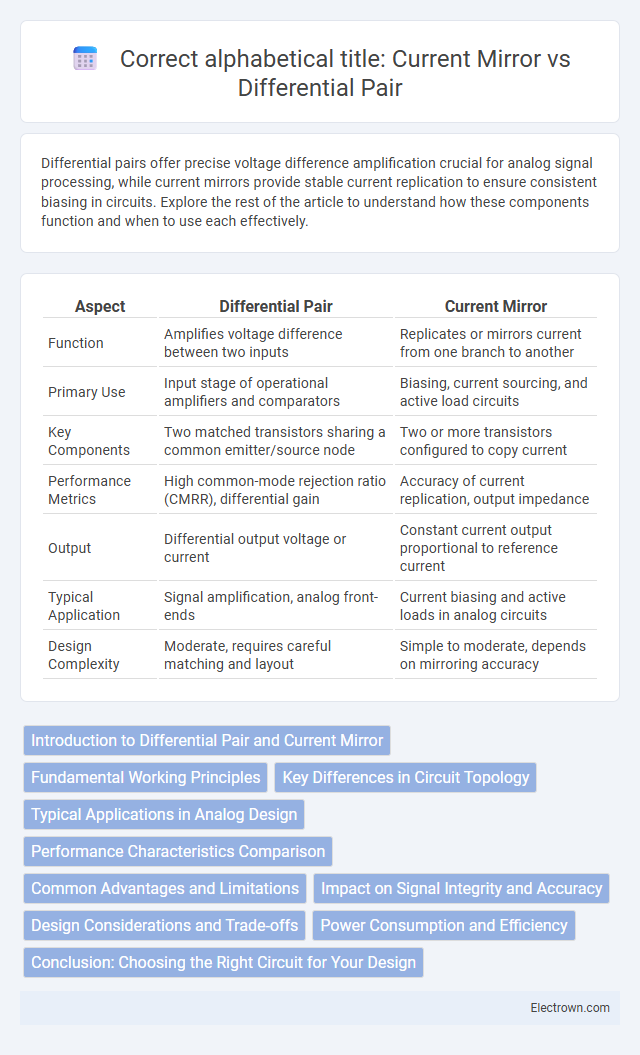Differential pairs offer precise voltage difference amplification crucial for analog signal processing, while current mirrors provide stable current replication to ensure consistent biasing in circuits. Explore the rest of the article to understand how these components function and when to use each effectively.
Table of Comparison
| Aspect | Differential Pair | Current Mirror |
|---|---|---|
| Function | Amplifies voltage difference between two inputs | Replicates or mirrors current from one branch to another |
| Primary Use | Input stage of operational amplifiers and comparators | Biasing, current sourcing, and active load circuits |
| Key Components | Two matched transistors sharing a common emitter/source node | Two or more transistors configured to copy current |
| Performance Metrics | High common-mode rejection ratio (CMRR), differential gain | Accuracy of current replication, output impedance |
| Output | Differential output voltage or current | Constant current output proportional to reference current |
| Typical Application | Signal amplification, analog front-ends | Current biasing and active loads in analog circuits |
| Design Complexity | Moderate, requires careful matching and layout | Simple to moderate, depends on mirroring accuracy |
Introduction to Differential Pair and Current Mirror
A Differential Pair is a fundamental analog circuit configuration that amplifies the voltage difference between two input signals while rejecting common-mode noise, making it essential in operational amplifiers and comparator designs. A Current Mirror, on the other hand, is a circuit used to copy a current from one active device to another, maintaining constant current levels crucial for biasing and active load applications in analog circuits. Understanding the distinct roles of Differential Pairs and Current Mirrors helps optimize your analog signal processing and circuit stability.
Fundamental Working Principles
A differential pair operates by comparing two input voltages and amplifying the difference between them, making it essential in analog signal processing for noise rejection and accurate signal amplification. A current mirror copies a reference current from one branch of a circuit to another, maintaining consistent current flow and providing stable biasing conditions. Understanding these fundamental working principles helps you choose the appropriate circuit configuration based on signal handling and current control requirements.
Key Differences in Circuit Topology
A differential pair consists of two transistors sharing a common emitter or source node, designed to amplify the voltage difference between two input signals, whereas a current mirror employs a pair of matched transistors to replicate current from one branch of a circuit to another, maintaining constant current flow. The key difference in circuit topology is that the differential pair requires differential inputs with a shared node for comparison, while the current mirror relies on feedback to enforce current replication through matched transistor configurations. Understanding these topological distinctions helps optimize your analog design for signal amplification versus current regulation tasks.
Typical Applications in Analog Design
Differential pairs are commonly used in input stages of operational amplifiers and comparators due to their excellent noise rejection and linearity, making them ideal for signal amplification and processing. Current mirrors serve as fundamental building blocks in biasing circuits and active load elements, ensuring stable and precise current replication for improved circuit performance. Your choice between these topologies depends on the need for accurate current copying or differential signal amplification within your analog design.
Performance Characteristics Comparison
Differential pairs offer high gain and excellent common-mode noise rejection, making them ideal for precision signal amplification in analog circuits. Current mirrors provide stable current replication with low input impedance, ensuring consistent biasing and improved linearity in transistor circuits. Your choice between the two depends on whether you prioritize signal integrity or current stability in high-performance analog designs.
Common Advantages and Limitations
Differential pairs and current mirrors both excel in precise current control and noise rejection, making them fundamental components in analog circuit design. Your choice between the two may hinge on their shared limitations, including susceptibility to transistor mismatches and limited output voltage swings. Understanding these common trade-offs helps optimize performance in high-accuracy amplifier and biasing applications.
Impact on Signal Integrity and Accuracy
Differential pairs enhance signal integrity by providing high common-mode noise rejection, ensuring accurate transmission of differential signals with minimal distortion. Current mirrors maintain accuracy in biasing and current replication, but their impact on signal integrity depends on matching precision and device characteristics. Your design choice should consider that differential pairs excel in reducing noise and improving signal fidelity, while current mirrors primarily affect accuracy in current control and bias stability.
Design Considerations and Trade-offs
Differential pairs offer high input impedance and excellent common-mode noise rejection, making them ideal for precision amplification, while current mirrors provide stable and predictable bias currents crucial for linear circuit operation. When designing, consider that differential pairs demand careful matching of transistor pairs to minimize offset and distortion, whereas current mirrors require accurate transistor sizing to maintain current accuracy and reduce output impedance variations. Your choice depends on whether input signal fidelity or bias current stability takes precedence, balancing complexity, power consumption, and performance requirements.
Power Consumption and Efficiency
Differential pairs typically consume less power by operating in the subthreshold region, offering higher efficiency in low-voltage, low-current designs, whereas current mirrors often draw more power due to bias currents needed for accurate replication. Your choice between these configurations depends on balancing power consumption with voltage headroom and output impedance requirements. Differential pairs excel in precision and efficiency for small-signal applications, while current mirrors provide stable current sources but at a higher power cost.
Conclusion: Choosing the Right Circuit for Your Design
Differential pairs excel in amplifying small differential signals with high linearity and common-mode noise rejection, making them ideal for precise analog front-ends. Current mirrors provide accurate current replication and biasing, crucial for stable current sources and improving circuit matching in integrated designs. Selecting between a differential pair and current mirror depends on whether signal amplification or current regulation is the primary design goal, ensuring optimal performance and efficiency in your application.
Differential Pair vs Current Mirror Infographic

 electrown.com
electrown.com